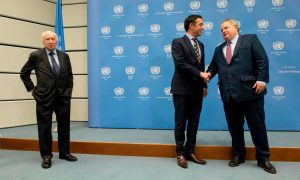By The Editorial Board The New York Times
The editorial board represents the opinions of the board, its editor and the publisher. It is separate from the newsroom and the Op-Ed section.
Anyone who thinks that it is trivial to rename the “Former Yugoslav Republic of Macedonia” as the “Republic of North Macedonia” best avoid traveling through the Balkans. In that maze of fierce and ancient grudges, using the wrong name can be very, very dangerous.
That is one reason Matthew Nimetz, a 78-year-old American diplomat, has dedicated more than 20 years to mediating a resolution of what must be one of the world’s most arcane, yet most intractable, disputes. And that is why Mr. Nimetz so warmly welcomed the agreement on a new name finally reached on Tuesday between the prime ministers of Macedonia and Greece.
The dispute goes back to the breakup of Yugoslavia in the early 1990s and the declaration of independence by one of its constituent republics as the “Republic of Macedonia.” Greece erupted in fury. To Greeks, “Macedonia” is not only the name of an important northern province but a centerpiece of their glorious antiquity when it was a great kingdom ruled by Philip II and Alexander the Great. The “Macedonians” of Yugoslavia were Slavs, not Greeks, they argued; their claim to the name was in effect a claim to Greek lands and Greek identity. A million Greeks went into the streets of Thessaloniki to protest in 1992 and there have been large periodic protestssince.
So to get into the United Nations, the new country had to settle for a seat as the “Former Yugoslav Republic of Macedonia,” contracted to a humiliating “Fyrom.” That was not the end of it — Macedonians refused to be seated among the “Fs,” and Greece refused to let them seat with the “Ms,” so they ended up with the “T’s”— “The Fyrom.” Still, Greece continued to block them from NATO and the European Union.
Macedonia (the former Yugoslav one) retaliated by demonstratively claiming to be the real heir of Alexander the Great. They named their airport and a major highway after him, and raised a gigantic statue in the center of the capital, Skopje, further fanning Greek fury.
From a safe distance, it might have seemed a local clash of competing myths (Bulgaria has its own version, but that doesn’t figure into the name dispute). But when tempers rise in the Balkans, history teaches that there is no safe distance (see: World War I and the war in Kosovo). So it was that in 1994, Mr. Nimetz began trying to resolve the name game, first as then-President Bill Clinton’s special envoy and then as the personal envoy of the United Nations secretary general.
His opening came when the left-leaning Zoran Zaev became prime minister of Macedonia a year ago. He is, like Prime Minister Alexis Tsipras of Greece, an anti-nationalist. Mr. Nimetz intensified his mediation, trying one adjective after another until both prime ministers agreed on “Northern.” Congratulations poured in from all sides.
They may be premature. Nationalists in both Greece and Macedonia remain opposed to any compromise. Mr. Zaev has promised to put the name to a referendum, while Mr. Tsipras’s right-wing coalition partner said it would oppose the agreement in Parliament. They would do far better to join Mr. Nimetz in celebrating “a period of enhanced relations,” and what could be the best real deal of the week.
Follow The New York Times Opinion section on Facebook and Twitter (@NYTOpinion), and sign up for the Opinion Today newsletter.




